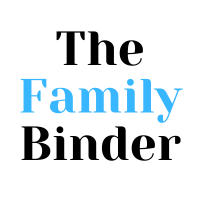The Family Binder: A Roadmap to Financial Literacy
Equipping your children with sound financial knowledge is a cornerstone of responsible parenting. In today's complex economic landscape, understanding money management is more crucial than ever. The Family Binder, a comprehensive digital family organization binder, offers a practical approach to organizing your family's vital information while serving as a valuable tool for financial education. Let's explore how to leverage this resource to instill financial responsibility in your children.
Understanding the Family Binder
Before delving into financial lessons, it's essential to familiarize your children with the Family Binder's structure. This family organizational binder is divided into seven key sections:
- Family and Friends: Contact information for loved ones.
- Our Home: Property details, maintenance records, and warranties.
- Insurance and Medical: Policies, providers, and emergency contacts.
- Personal Finance: Financial accounts, investments, and tax information.
- Debt & Loans: Outstanding debts, payment schedules, and credit information.
- Estate Documents: Wills, trusts, and power of attorney documents.
- Online Information: Digital assets, passwords, and social media accounts.
By understanding the purpose of each section, your children will grasp the importance of comprehensive financial organization.

Building a Foundation: Financial Organization
Introduce your children to the concept of financial organization by exploring the "Personal Finance" section together. Explain how this section serves as a central hub for managing the family's financial well-being. This is an excellent opportunity to introduce fundamental financial concepts such as budgeting, saving, and investing.
Budgeting Basics: A Family Affair
Creating a budget is a fundamental financial skill. By involving your children in the budgeting process, you can help them develop a practical understanding of money management.
- Income: Discuss the family's income sources, emphasizing the value of hard work and various income streams.
- Expenses: Categorize expenses into fixed and variable costs, explaining the difference between needs and wants.
- Savings: Highlight the importance of saving for short-term goals (like vacations) and long-term objectives (like college or a down payment).
- Tracking Progress: Use the Family Binder to monitor your family's spending and savings habits, encouraging open conversations about financial goals.
Tip: Create a simplified budget worksheet for your children to practice budgeting their allowance or earnings from part-time jobs.

Navigating the Debt Landscape
Debt is a common financial reality, and teaching your children about responsible borrowing is crucial. Use the "Debt & Loans" section to illustrate different types of debt and their implications.
- Interest Rates: Explain how interest works and how it can impact the overall cost of borrowing.
- Credit Scores: Discuss the importance of building and maintaining good credit.
- Debt Management: Emphasize the value of creating a debt repayment plan and the consequences of excessive debt.
Activity: Role-play different borrowing scenarios to help your children understand the pros and cons of taking on debt.

Don't wait. Protect your family's financial well-being.
Order your Family Binder today.
Planning for the Future: A Long-Term Perspective
The "Estate Documents" and "Insurance and Medical" sections offer valuable insights into long-term financial planning. While these topics might seem complex, they are essential for building a strong financial foundation.
- Insurance: Explain the role of insurance in protecting assets and mitigating risks.
- Estate Planning: Discuss the importance of having a will and other estate planning documents in place.
- Legacy Building: Talk about the concept of leaving a financial legacy for future generations.
Activity: Create a family "time capsule" to encapsulate your family's values and financial goals.

Empowering the Next Generation
Financial education is an ongoing process. Encourage your children to take ownership of their financial journey by involving them in maintaining the Family Binder.
- Goal Setting: Help your children set financial goals and track their progress.
- Financial Record-Keeping: Teach them the importance of documenting income, expenses, and savings.
- Digital Literacy: Discuss the risks and rewards of online banking and investing.
By fostering a culture of financial responsibility within your family, you're equipping your children with the tools they need to thrive in today's world. The Family Binder is more than just an organizer; it's a catalyst for financial empowerment.
By empowering your children with financial knowledge and instilling responsible money habits, you're investing in their future success. The Family Binder is your partner in this journey. Its comprehensive structure and user-friendly format make it an invaluable tool for organizing your family's life while educating your children about financial management.

Ready to start this transformative journey?
Purchase The Family Binder today and start building a strong financial foundation for your family. With its immediate digital delivery and editable format, you can begin organizing and educating your loved ones right away.
Don't miss this opportunity to secure your family's financial well-being and create a lasting legacy of financial responsibility.
Remember: Early financial education is a gift that keeps on giving. Invest in your children's future today.

